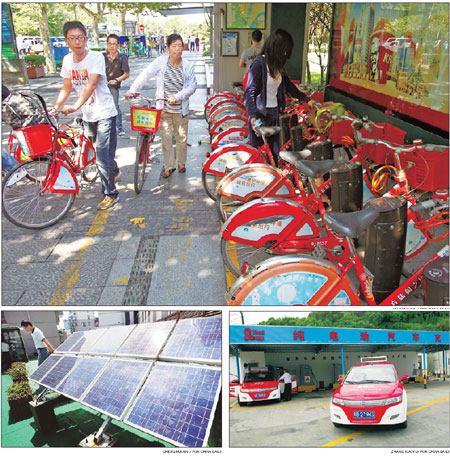Focus
Industrial zones come clean due to green drive
By Li Jing (China Daily)
Updated: 2010-11-11 08:21
 |
Large Medium Small |
|
|
Early guess work
Several of the pilot zones have been brave enough to put their numbers on table and, although some are sticking close to the national goal, others have shown rather more ambition.
Hangzhou, capital of East China's Zhejiang province, for example, aims to reduce carbon intensity by about 35 percent by 2015 and 50 percent by 2020, said Xu Dongmin, who is overseeing the low-carbon plan for the city's development and reform commission.
Baoding in North China's Hebei province, however, is chasing a 48-percent reduction target by 2020, while Guiyang, a third-tier city in Southwest China, is keeping a modest pace and sticking to 45 percent.
A closer look at the numbers may help explain why some officials have been maintaining a low profile on their targets and plans.
As part of efforts to meet the energy efficiency target set in the 11th Five-Year Plan (2006-2010), China's energy auditing system was greatly improved nationwide. Yet, little information is still available in regard to greenhouse gas emissions.
Without a detailed breakdown of how much carbon each industry emits, it is difficult to judge what measures are most effective. As a result, some officials and experts admitted to China Daily they have made only "preliminary calculations and rough estimates" when proposing their targets.
Wang Ke, executive director of the Energy and Climate Economics Program at Renmin University of China, argued that estimations based on energy consumption statistics will not result in a fundamental change to the big picture and, therefore, provide a valid reference for policymakers.
But emissions from sectors such as construction and transportation, as well as household pollution, are often left out of these estimations, he said.
"We are working on a carbon-emissions inventory, which is expected to be finished next year." said Xu Dongmin in Hangzhou, "With that, it will be easier to break down targets into different industries and sectors."
Wang said he believes what matters now is action, not details.
"It would be ideal if we had all the calculations done before setting the targets and taking action," he said, "but considering we're basically starting from nothing, keeping the ball rolling is equally important."
It is also interesting that different cities and provinces have assigned the task of carbon accounting to different authorities.
Guiyang, capital of Guizhou province, plans to establish a new taskforce in collaboration with the energy auditing system; in Hangzhou, the development and reform commission will lead the task, meanwhile Guangdong officials have announced the provincial meteorological bureau will be in charge of setting up a monitoring platform for greenhouse gas emissions.
Having a clear picture of the sources of carbon emissions is a "prerequisite" for meeting the country's 2020 target, according to Sun Cuihua of the NDRC's climate change department. She said the government is working hard to enhance its capacity in terms of drafting a carbon-emissions inventory and improving the accuracy and credibility of statistics.
